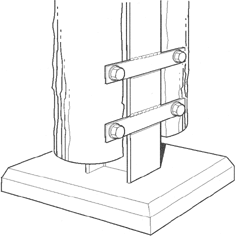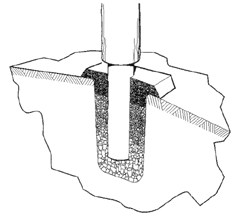Totem Poles Displayed Outside – Canadian Conservation Institute (CCI) Notes 6/8
Introduction
As a result of the recent revival in totem pole carving, many museums are now acquiring these works and must learn to safeguard them. This Note discusses suitable handling and care procedures for totem poles displayed outside. Although the information is intended primarily for freshly constructed poles, it also applies to older poles. Similar advice for display inside can be found in CCI Notes 6/7 Totem Poles Displayed Indoors.
All true totem poles are carved from western redcedar (Thuja plicata), a low-density, straight-grained, aromatic softwood that is exceptionally durable. Totem poles intended for outdoor exhibition may be traditional poles with an uncarved 'foot' (usually about 10 % of the pole's total length) that is intended to be buried in the ground. More commonly, however, they will lack this uncarved foot and must be supported by some external means.
Choosing a Location
Totem poles should be displayed where their dramatic effect can be maximized, not where they will be overwhelmed by surrounding buildings. Open, exposed locations that provide for easy photographing and viewing from a distance will allow the full effect of the poles to be appreciated. These locations also have the advantage of good light and air circulation, which will discourage the growth of moss and wood-rotting fungi.
Do not place totem poles close to trees or bushes, which restrict air flow and create a damp environment. If poles must be placed close to buildings or attached to them, ensure the poles are clear of the drip line.
Protection
Totem poles always check (i.e. crack or split) to some extent during or immediately after carving; checks up to about 2 cm in width are normal on full-size poles. This process is rarely serious and not likely to weaken the pole. However, when poles are exposed to the elements (i.e. displayed outside), these checks provide access for air, water, and micro-organisms. Despite western redcedar's exceptional natural resistance, rotting will eventually occur if poles are not protected with a fungicide. Commissioned poles may have been treated with a colourless fungicide after carving and before painting, but this is rare. Most poles have not been so treated, and must have an application of fungicide before installation.
When applying fungicide, pay special attention to all exposed endgrain (particularly at the ends of the pole) and to mortices and visible cracks. If the pole has a foot that is to be planted in the ground, treat it heavily with fungicide up to about 25 cm above the ground.
Long-term fungicidal protection with borates is strongly advised. This is discussed in Sheetz and Fisher ("Bibliography"). The use of commercially available Impel rods [solid fused borate cylinders that contain DOT (D isodium octaborate tetrahydrate)] is also suggested. These rods will survive for 3–10 years, depending on the climatic conditions; they require regular replacement.
Cap the top of the pole with flexible, durable, waterproof material that can be moulded to cover the entire top surface and project about 1 cm beyond the edge, all around. Copper, lead, and zinc sheet can be used, but asphalt roof shingles are probably the most effective material. Shingles can be selected to match the pole, and can easily be cut to the desired shape and secured with galvanized roofing nails. Do not seal the bottom end of the pole in any way.
Supporting a Pole Without a Foot
If the pole does not have a foot, it will require an external support. This is an engineering problem beyond the scope of this Note, and will require the advice of a civil engineer or an architect in consultation with a conservator. However, the following general remarks may be useful in designing a support.
The easiest solution is to fix the pole to the side of a building, observing the precautions outlined in CCI Notes 6/7 Totem Poles Displayed Indoors. Outdoor poles should also be raised 10–15 cm off the ground to prevent absorption of water and to ensure air circulation. There are several ways to achieve this: a steel mesh plinth or shelf can be made, steel brackets can be angled out from the wall and bolted to the pole, or four or five bricks can be placed on their sides on a concrete slab. Do not use wood for the support because it will wick moisture up into the pole and present a potential source of fungus attack. Similarly, keep the pole free of vegetation and clear of the roof drip line, and drain the soil beneath it well.
A pole that is to stand clear of buildings must be bolted or strapped to a support that can resist lateral forces such as earthquakes and high winds (such a support is best designed by an engineer). Most vertical supports consist of one or more steel box beams, I-beams, or U-channels set in a substantial concrete base. These supports can sometimes be hidden by concealing them in channels cut in the back of the pole, and the heads of the bolts at the front of the pole can be recessed and covered by wooden plugs which can be carved and painted to match the rest of the pole. Do not use wooden supporting posts because they will have a short life, especially if set in cement.
Free-standing poles supported by an external structure must also be raised above their concrete bases to allow air circulation, and this can be accomplished using the same methods as outlined previously for poles attached to a building. Ensure too that the concrete base is large enough to keep vegetation at a distance, and that its surface is slightly domed to drain water away from the pole.
The fragile, fibrous nature of the wood must be kept in mind when attaching a pole to its supporting structure. If two or more bolt holes are drilled through the pole in vertical alignment, they will create a line of weakness which, under stress, may split the pole.

Supporting a Pole With a Foot
The traditional way of raising a totem pole (i.e. planting its foot firmly in well-drained ground) is by far the most satisfactory method because it avoids the use of straps and bolts. However, to ensure a long life, the pole and the site must be correctly prepared and maintained.
Soak the foot of the pole heavily with fungicide (borates are recommended) before planting it.
The pit in which the foot is to be set must be well drained. Dig this hole deeper and wider than the foot, and line the bottom with at least two layers of smooth stones. Carefully pack more rocks of various sizes around the foot, building up layers of rock to within about 15 cm of the top of the hole. Each layer should be packed down and filled in with coarse gravel. Fill the final 15 cm with gravel, leaving the surface slightly domed and a few centimetres above the surrounding earth.
If necessary (e.g. in the centre of a courtyard), top the surface surrounding the pole with a layer of cement, domed to encourage run-off. Never set the pole itself in a solid concrete base as this will collect and retain water, which will encourage rotting. Even careful caulking of the junction between the pole and the cement with bitumen or some other plastic material will not prevent rotting; the foot must be able to drain and have exposure to air.

Maintenance
Inspect the entire surface of all poles each spring and fall, and record the findings. Keep this inspection record to help guide responses to problems in following years. Endgrain areas are the most vulnerable to deterioration by general weathering or water washing away the natural and/or applied biocides. The presence of lichen forebodes fungal attack, and indicates that the level of biocides has decreased. Clean poles by brushing them with a soft painters brush. If they require washing with water, contact a conservator.
Carpenter ants in the earth can attack a pole, hidden from sight. To deter them, maintain an air space between the pole and the earth. Prevent earth and/or debris from collecting in this area.
Keep the bottom of all poles free of vegetation and any debris or obstruction that might inhibit circulation of air. Remove any leaves, organic debris, and rooting plants or seedlings within a 1-m radius of the pole. Trim away any trees and bushes within 2 m of a pole, so that windstorms cannot cause branches to strike it. Also remove any trees that could strike the pole if they were blown down by a storm.
If the pole is planted, scatter a granular herbicide on the gravel around it each spring. Weed by hand to control weeds that persist despite application of the herbicide. Every 3 or 4 years, pour fungicide against the pole just above the gravel and allow it to seep down.
Apply borate fungicide every 5–8 years whether fungus appears or not; the frequency of this re-application will depend on weather conditions and display location. Painting poles does not contribute to their preservation. If repainting is contemplated for aesthetic reasons, contact the original artists (if possible) and hire them to carry out the work.
Inspect the base of any pole that has its bottom end buried in earth or concrete for rot after 40 years of display outdoors. Use a tool such as an IML ResistographEndnote 1 because western redcedar rots from the inside to the outside. Even a greatly weakened pole may not show any visual evidence of rot.
Suppliers
Note: The following information is provided only to assist the reader. Inclusion of a company name does not in any way imply endorsement by the Canadian Conservation Institute.
Impel Rods and borate fungicides
The Sansin Corporation
111 MacNab Avenue
Strathroy, ON N7G 4J6
Canada
Telephone: 1-519-245-2001 or 1-877-726-7461
Broda Coatings Ltd.
102-876 Cordova DVSN
Vancouver, BC V6A 3R3
Telephone: 604-254-3325 or 1-800-311-5339
For additional information on Impel Rods and borate fungicides (such as Tim-bor), visit the Wood Care Systems website.
Resistograph
IML, Inc.
15 Glidden Road
Moultonborough, NH 03254
USA
Telephone: 1-603-253-4600
Bibliography
Canadian Conservation Institute. Totem Poles Displayed Indoors. CCI Notes 6/7. Ottawa, ON: Canadian Conservation Institute, 2002.
Sheetz, R. Protecting Wood With Preservatives and Water Repellants. Conserve O Gram 7/3. Washington, D.C.: United States National Park Service, July 1993.
Sheetz, R., and C. Fisher. Exterior Woodwork No 4: Protecting Woodwork Against Decay Using Borate Preservatives. Preservation Tech Notes. Washington, D.C.: United States National Park Service, October 1993.
First edition by Philip Ward (2002)
Second edition by David Grattan, Robert L. Barclay, and James Hay (2009)
Revised in 2024
© Government of Canada, Canadian Conservation Institute, 2024
Cat. Nº NM95-57/6-8-2008E
ISSN 0714-6221